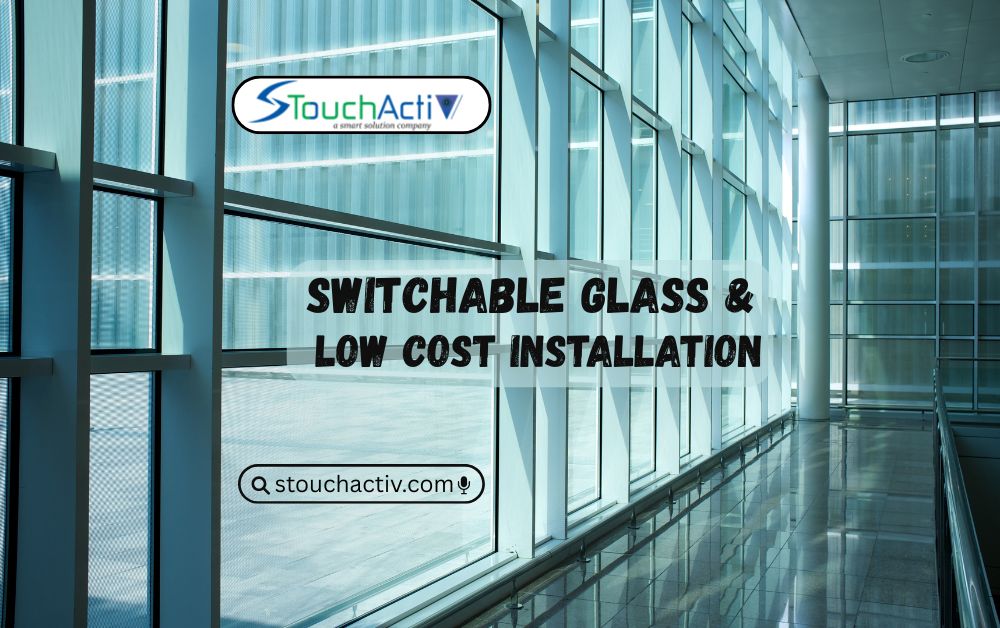Pros & cons of Switchable Glass & low cost Installation

Switchable glass, also called smart glass, is a revolutionary material in the world of architecture and interior design. With just a button, it can shift from transparent to opaque, offering privacy and flexibility without the need for curtains or blinds. This feature has made it increasingly popular in both homes and businesses. Although once considered expensive, recent innovations and demand have paved the way for low-cost installation, making it more accessible.
What is Switchable Glass?
Switchable glass is a glazing material that uses Polymer Dispersed Liquid Crystal (PDLC) technology to control transparency. When powered, liquid crystals align to make the glass clear; when turned off, they scatter, creating a frosted look.
Its flexibility allows it to be used in residential projects, corporate offices, hospitals, hospitality, and even retail showrooms. The combination of privacy and style makes it a futuristic choice for modern interiors.
Pros vs Cons of Switchable Glass
| Pros | Cons |
| Instant privacy on demand | Higher upfront cost compared to normal glass |
| Improves energy efficiency by reducing heat & glare | Requires electricity to remain transparent |
| Sleek, modern, and minimalist look | Limited design and color options |
| Easy to clean and maintain | Professional installation is necessary |
| Works in many applications (homes, offices, hospitals) | Durability may be affected by scratches or moisture |
Applications of Switchable Glass
One of the reasons behind its rising popularity is its wide range of applications. Some of the most common uses include:
- Corporate Offices: Meeting rooms and cabins use switchable glass for instant privacy during discussions while keeping spaces open when needed.
- Healthcare Facilities: Hospitals and clinics install it in patient rooms for both comfort and hygiene, as there are no fabrics to collect dust.
- Hospitality Sector: Hotels adopt it in bathrooms and partitions to enhance luxury and guest privacy.
- Residential Homes: Homeowners install it in living rooms, bathrooms, and smart home setups for a futuristic look.
- Retail Stores: Stores use it in display windows, where glass can change from frosted to transparent to highlight products creatively.
Low-Cost Installation Options
Though premium at first glance, switchable glass can be installed affordably with the right approach:
- Targeted Use – Instead of fitting it everywhere, install it only in critical areas such as bathrooms, partitions, or offices.
- Switchable Films – A budget-friendly option where a film is applied to existing panels, delivering similar performance at a lower cost.
- Bulk Installations – Purchasing larger quantities reduces the cost per unit.
- Energy Efficiency Benefits – Over time, reduced cooling expenses and the absence of blinds or curtains help balance the investment.
- Long-Term Durability – Though initial pricing is higher, the longevity of the product ensures lasting value.
Maintenance Tips for Longer Lifespan
To maximize durability and performance, here are a few essential care practices:
- Regular Cleaning: Use non-abrasive cleaners to avoid scratches.
- Moisture Protection: Ensure installations in bathrooms or kitchens are properly sealed.
- Avoid Sharp Objects: Prevent direct contact with tools or furniture that could damage the glass surface.
- Check Wiring: Since it relies on electricity, regular inspection of wiring and connections is recommended.
FAQs
- How long does switchable glass last?
On average, it lasts 10–15 years when properly maintained, making it a long-term investment.
- Can it be used in bathrooms or kitchens?
Yes, it is safe for moisture-prone areas if sealed correctly during installation.
- Does it consume much electricity?
No, it consumes very little energy—around 5 watts per square meter when switched on.
- Can existing windows be upgraded with this technology?
Yes, retrofit films can be applied to current panels, saving the cost of complete replacement.
- Is switchable glass worth the price?
For those who value privacy, modern design, and long-term efficiency, it offers excellent value despite a higher upfront cost.
Conclusion
Switchable glass is a modern solution that blends privacy, energy efficiency, and cutting-edge style. While the pros and cons must be considered carefully, affordable installation methods—like selective use and retrofit films—make it a practical option for both homes and businesses.
With proper maintenance, it delivers lasting performance and adds a futuristic touch to interiors. As more cost-effective solutions emerge, this smart glass technology is no longer just for luxury projects but a practical upgrade for anyone looking to modernize their space.
To maximize durability and performance, here are a few essential care practices:
- Regular Cleaning: Use non-abrasive cleaners to avoid scratches.
- Moisture Protection: Ensure installations in bathrooms or kitchens are properly sealed.
- Avoid Sharp Objects: Prevent direct contact with tools or furniture that could damage the glass surface.
Check Wiring: Since it relies on electricity, regular inspection of wiring and connections is recommended.
Switchable glass is a modern solution that blends privacy, energy efficiency, and cutting-edge style. While the pros and cons must be considered carefully, affordable installation methods—like selective use and retrofit films—make it a practical option for both homes and businesses.
With proper maintenance, it delivers lasting performance and adds a futuristic touch to interiors. As more cost-effective solutions emerge, this smart glass technology is no longer just for luxury projects but a practical upgrade for anyone looking to modernize their space.







Leave a Comment